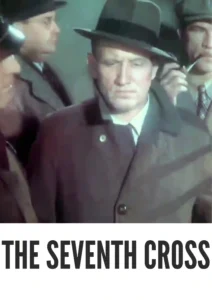Video Sources 0 Views

Synopsis

Immerse yourself in the intensity of World War II with The Seventh Cross, a powerful drama from 1944, now beautifully colorized for a viewing experience that resonates with hope and resilience. Starring Spencer Tracy, this film, based on Anna Seghers’ novel, portrays the harrowing journey of escape and the strength of human solidarity against the backdrop of Nazi Germany. Perfect for enthusiasts of historical dramas and stories of courage, this HD download brings a timeless tale of defiance to your screen. Also known under the title Siete Cruces.
The Seventh Cross tells the story of seven prisoners who daringly escape a German concentration camp. The camp commandant, determined to recapture them, erects seven crosses, promising to display each escapee upon their capture. As the hunt intensifies, one by one, the prisoners are caught, and their bodies are displayed as a grim warning.The film primarily focuses on Georg Heisler (Spencer Tracy), the seventh escapee, as he desperately tries to evade capture. While his fellow escapees lose hope and succumb to the oppressive environment, Georg finds refuge and assistance from ordinary German citizens who risk their lives to protect him. These acts of kindness and bravery highlight the resilience of the human spirit in the face of unimaginable cruelty. Georg’s journey is a testament to the power of hope, courage, and the solidarity that can emerge even in the darkest of times.
The Seventh Cross features a stellar cast of actors who bring depth and authenticity to this poignant story:
- Spencer Tracy as Georg Heisler
- Signe Hasso as Toni
- Hume Cronyn as Paul Roeder
- Jessica Tandy as Liesel Roeder
- Agnes Moorehead as Mrs. Marelli
The Seventh Cross falls into the genre of wartime drama, with strong elements of suspense and thriller. Its compelling narrative and emotionally charged scenes make it a powerful and unforgettable cinematic experience. The movie explores themes of resistance, hope, and the moral dilemmas faced by individuals living under oppressive regimes, making it a thought-provoking and relevant film.
Released in 1944, The Seventh Cross reflects Hollywood’s growing involvement in addressing the realities of World War II and expressing anti-Nazi sentiments. The film was produced during a time when the world was grappling with the atrocities of the Holocaust and the widespread oppression of Nazi Germany. The Seventh Cross is significant for its portrayal of German citizens who actively resisted the Nazi regime, offering a nuanced perspective on the complexities of life during wartime. It stands as a testament to the power of cinema to raise awareness, inspire hope, and promote human solidarity in the face of adversity.
This colorized version of The Seventh Cross has been meticulously restored using state-of-the-art digital techniques, enhancing the visual impact while preserving the film’s historical integrity. The colorization process involved careful analysis of the original black and white footage, with historians and film experts consulting to ensure accuracy and authenticity. Advanced algorithms were used to select appropriate color palettes and enhance image details, bringing new life to the characters, settings, and emotional nuances of the story. This painstaking process aims to provide a more immersive and engaging viewing experience for modern audiences, while honoring the film’s original message and artistic vision.
- : Fred Zinnemann
- : Helen Deutsch
- : the novel The Seventh Cross by Anna Seghers
- : Karl Freund
- : Tom Held
- : Metro-Goldwyn-Mayer (MGM)
- : Loew’s, Inc.
- : 102 minutes
- : MP4
- : HD (1080p)
- : Compatible with most devices, including smartphones, tablets, computers, and smart TVs.
The Seventh Cross (1944) received critical acclaim upon its release for its powerful storytelling, strong performances, and its courageous portrayal of resistance against Nazi oppression. Spencer Tracy’s performance was particularly praised, and the film was recognized for its emotional depth and historical significance. The Seventh Cross remains a relevant and impactful film that continues to resonate with audiences today.
- : What is The Seventh Cross about?
- A: The Seventh Cross is a wartime drama about seven prisoners who escape a concentration camp, focusing on one man’s struggle for survival and the ordinary citizens who help him.
- : Is The Seventh Cross (1944) based on a book?
- A: Yes, the film is based on Anna Seghers’ novel of the same name.
- : Is this version of The Seventh Cross colorized?
- A: Yes, this version has been professionally colorized to enhance the viewing experience.
- : What makes The Seventh Cross a significant film?
- A: The Seventh Cross is significant for its powerful portrayal of resistance against Nazi oppression and its exploration of human solidarity in the face of adversity.
- : What is the download format?
- A: The download format is MP4, which is compatible with most devices.
- : What resolution is the download?
- A: The resolution is HD (1080p), providing a high-quality viewing experience.
Experience The Seventh Cross Today!











